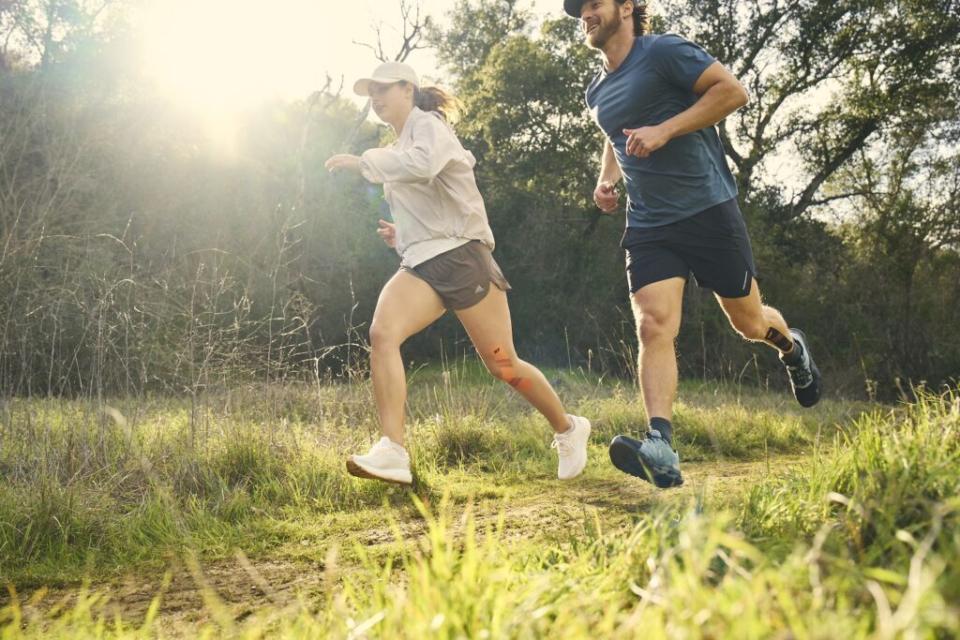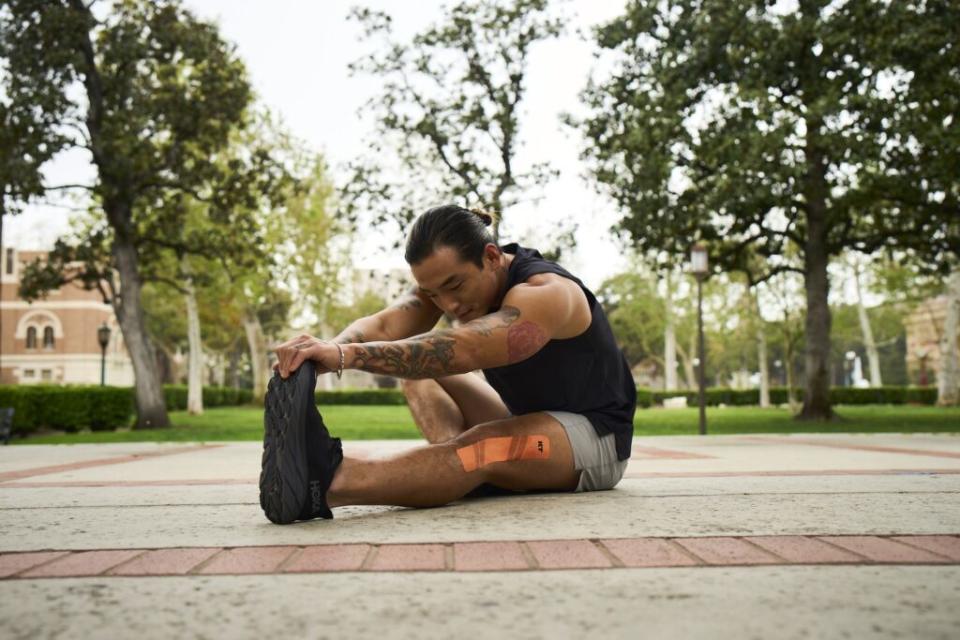Tips for Pain-Free Exercise
This article originally appeared on Outside
Sure, exercise can hurt. But there are two kinds of pain: the lung-searing, muscle-burning athletic kind that makes you feel alive in your body; and the "ouch" kind that limits your ability to keep doing what you love. The limit-pushing pain you feel on a hike, run, or long day in the saddle? That's the hurt-so-good kind. The type of pain that makes you adjust your wants or needs of outdoor adventure, however, or an injury of any sort? That requires more attention and often more effort in the form of preventative measures and treatment. The good news is that both kinds of pain can benefit greatly from some simple body maintenance, plus smart gear and equipment choices.
Of course, if you experience an acute injury that doesn't improve or gets worse (compared to typical muscle soreness, which can last up to 72 hours), seek a diagnosis and plan from a medical professional. But, for the common aches and pains from using your body to stay active outside, the following tips can keep you moving.
Preventative Measures and Treatment Strategies
There are certain things all athletes--no matter the sport or activity--should do to try to prevent strains, sprains, and pains of all kinds. "I like to use the term 'pre-hab’ when talking about body maintenance," says Dr. Matt Tanneberg, a sports chiropractor and Certified Strength and Conditioning Specialist (CSCS) in Scottsdale, Arizona. "The idea of pre-hab is to preventatively take care of potential issues." Many of the following "pre-hab" strategies also apply to rehabilitating injuries. Use them to maximize your potential for avoiding the worrisome kind of "ouch" pain, so you can focus on the "ohhhh ya" feedback type of pain that lets you know you're getting fit.
Support weaknesses
Whether you have a known weakness or are coming off an injury, utilizing a kinesiology therapeutic tape like KT Tape can both mitigate unwanted pain and aid in recovery. Unlike old-school athletic tape, this elastic tape works by supporting the muscle or joint while allowing the affected area to move naturally, comfortably unrestricted, due to its stretchable fabric makeup. KT Tape also lifts the surface of the skin slightly which temporarily increases local blood flow to the area.
"With improved blood flow and circulation, 'good' blood and cells come into the affected area to heal, and excess blood and cells are allowed to clear out of the area," explains Tanneberg, who uses kinesiology tape in his chiropractic and sports rehabilitation business. KT Tape provides support and stability to compromised areas similarly to a brace. "However," says Tanneberg, "the tape does not rigidly hold a muscle or joint in one position. It adds support while still allowing the body part to function." Regularly taping an injured area can help retrain that body part to function normally, whether you're getting out of a brace (or cast), recovering from a minor injury, or simply dealing with day-to-day aches and nagging pains from your exercise routine. "It allows the body to take on more load incrementally," says Tanneberg.

Sleep and eat well
Studies have shown that getting enough sleep can increase everything from athletic reaction time to speed, while chronic lack of sleep can contribute to increased sports injuries and illness. Not only does being well-rested cut down factors that contribute to trips, falls, or accidents due to fatigue, but sleep also allows our bodies to repair themselves from our athletic endeavors.
Fueling properly--with a well-balanced diet--is imperative to athletic performance and can also help speed up recovery time following injuries. A 2020 study published in the journal, Nutrients, states that macro- and micro-nutrients, "play an important role in metabolism, energy production, hemoglobin synthesis, lean mass and bone mass maintenance, immunity, health, and protection against oxidative damage." The study also emphasizes "quality proteins" which can help muscles and connective tissues heal themselves.
Build up and warm up
Whatever your choice of endurance activity, it's important to build up to your larger goals. That progression may mean following a training plan that matches your current fitness baseline, or it may simply mean using common sense (i.e., don't launch a massive hike on your first day out if you've spent the winter skiing). The term "baby steps" applies to sport-specific activity, and a gradual build-up can help you avoid injury.
Most running coaches advise starting every run with 5 minutes of walking; it's good advice that crosses disciplines, too, if you're hiking (start slowly) or cycling (start spinning in a low gear for the first 5 to 15 minutes of your ride). "Warming up" does just that: It warms up your muscles, joints, connective tissue, and cardiovascular system before you kick things into high gear.
Use the right gear before, during, and after exercise
Running, hiking, and cycling in footwear that both fits you well and suits your needs is imperative to maintain proper alignment and not be the cause of injuries. An ill-fitting bike or backpack, or even socks that cause blisters, can lead to injury--a blister can impact your gait, causing localized discomfort and greater issues with imbalances and overcompensation pains (walking/running funny to avoid pressure on the blister.)
And before and after exercise? Regular strength training, a couple key recovery tools, plus stretching/mobility exercises can keep your whole body ready for action. Runners, hikers, and cyclists benefit from strength training that targets muscles used in their sports, but also muscles that aren't so obvious, like the upper body. Keeping your whole system strong and supple (hit that foam roller or massage gun) can help ward off injuries, as can regular sports massage, physical therapy, or chiropractic treatments.

RICE and minimizing inflammation
For acute or chronic injuries, sports medicine practitioners have long advised rest, ice, compression, and elevation. For a sprained ankle, for instance, rest by staying off of it. Ice the injury. Add support with KT Tape and a bandage wrap or compression sock to increase circulation (products like the KT Recovery+ Ice Sleeve combine flexible compression and icing). Finally, elevate the injury by propping up your foot. Keeping the injury above the level of your heart (propped up with pillows), can minimize swelling.
And to further mitigate inflammation, which can cause pain, consider anti-inflammatories such as ibuprofen, or homeopathic anti-inflammatories like arnica gels, creams, or pellets. (Ask a medical practitioner about what you should or shouldn't take for various symptoms.) Epsom salt baths can also help detoxify muscles, with plenty of anecdotal reports they relieve stress and decrease inflammation--with rest and relaxation being the final key to help minimize pain.
Recover
Give your body enough time to rest between workouts, especially as you're building up to big endeavors like long hikes, runs, rides or other major outdoor exertion adventures. Sleep well. Eat well. Treat muscles with a foam roller or massage gun. Keep that KT Tape on for up to a week between workouts to stay ready--and to reduce delayed onset muscle soreness between sessions. Additionally, visit a massage therapist, physical therapist, or chiropractor regularly for general body maintenance or to address any lingering pains.
These preventative strategies can help both avoid excessive pain and treat it. A little body maintenance--and smart strategies like strength training, foam rolling, and effective kinesiology taping--can make all the difference in embracing 'good pain,' avoiding 'bad' pain, and staying active doing the things you love.
KT Tape moves with you so you can crush every moment and unleash your potential. The product provides long-lasting support and pain relief for muscles, tendons, and ligaments for anyone who loves to move, wherever your adventures take you.
For exclusive access to all of our fitness, gear, adventure, and travel stories, plus discounts on trips, events, and gear, sign up for Outside+ today.

